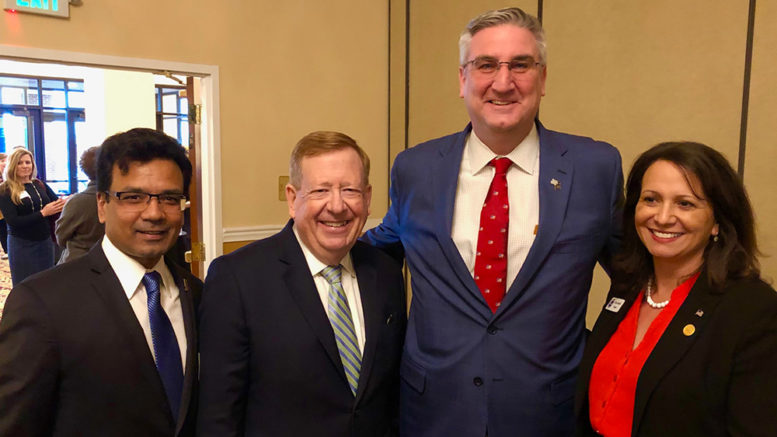Just before speaking to the over 500 Republicans who gathered Friday night at the 502 East Event Center in Carmel for the 2019 Lincoln Day dinner, Indiana Governor Eric Holcomb sat down with The Reporter to talk about economic development, teacher pay and the vital role Hamilton County plays in the state’s success.
“Hamilton County has long been an engine to the state’s economy,” Holcomb told The Reporter. “It is because the pieces fit together in a beautiful fashion. That is: Making sure you have good local government from the schools to the municipalities to the towns and the county all oaring together and moving in the right direction. Low crime, safe cities, good streets – these are the basics.”
According to Holcomb, when an area gets those things right in a state that is known to be growing, as Indiana is, “That’s a match made in heaven. When those two fit together, good things happen. Hamilton county is a HUGE part of the state of Indiana’s success.”
Holcomb told The Reporter Indiana has set two recent records for new job commitment. Having broken the 2012 record in 2017, the growth in 2018 showed record growth once again.
“We are finding ourselves in a situation where we face a good problem to have: We have more jobs available than we have people qualified to fill them,” Holcomb said. “There is good news on that front as well. Because we are in the heart of the heartland – the center of all the action – we are closer to the population. We are within a 12-hour drive of 70 percent of the nation’s population. That’s a real strength. But you have to have the people to fill the jobs that are being created to make those products, to create and to innovate. We have been laser-focused on our workforce development efforts like never before.”
Employers in Hamilton County and the entire state face a challenge in finding employees with the necessary skills to fill the available jobs in the current market. Holcomb’s phrase for implementing extended and continuing education needed to fit local employees to the changing job market is to get people “skilled up” for the job market.
“We are starting to get talent pipelines where folks can be skilled up from a regional perspective and be able to address those needs the marketplace is experiencing,” Holcomb said. “We need more people in life sciences, we need more people in construction, we need more people in transformational logistics, we need more people in advanced manufacturing.”

Over 500 people attended the 2019 Lincoln Day dinner and reception Friday at which Governor Eric Holcomb was the featured guest speaker. (Photo provided by Denise Moe)
Indiana is the number one manufacturing state in the nation according to Holcomb.
“If we want to be the number one advanced manufacturing state in the nation in 15 years, we have to make sure we are comparing our students and retraining our adults,” Holcomb said. “The good news is we are looking at this person by person, not just numerically. We understand that there are 450,000 Hoosiers who do not have a high school diploma. What are we going to do about that for each and every one of those individuals? We understand there are 540,000 Hoosiers who started college and dropped out for some reason. How are we connect those people with the skill sets they need to double or triple their income right now? We are constantly trying to appeal to someone’s maximum potential – not some temporary, minimum station in life.”
When asked about getting people “skilled up” for the current economy, The Reporter asked Holcomb about his plan to deal with the reality that teachers who help prepare young people for their adult lives are leaving the profession to seek better personal opportunities in the private sector.
“Just to take a step back, that’s happening across the whole workforce spectrum,” Holcomb said. “Because of this roaring economy we find ourselves in, people are more transient today than ever before because businesses are appealing – as you would expect them to – to talent. It’s an uber-competitive environment right now and obviously teachers are some of the more trusted, talented, caring individuals in society. I understand that an offer can be very enticing, especially when you add in the ability for private sector to pay for the talent they are seeking.”
Holcomb went on to say then in this changing economic landscape, Indiana wants to be a “talent magnet” for teachers in states around us.
“We do not want to lose teachers to other states or to businesses,” Holcomb said. “Therefore, we have taken a two-step approach. One is an immediate step. I proposed a 2 percent increase to K through 12 education next year and a 2 percent the following year. I also said we want to devote $150 million to pay off a pension liability that every school is paying right now. It’s almost like you are paying off someone’s mortgage. They can use that money to direct it to teachers and give them the pay raise right now.”
The governor clarified that state of Indiana doesn’t pay teachers directly. That is collectively bargained on a local basis.
“I think the state has the right priority because the biggest chunk out of our budget – over 50 percent – goes to education,” Holcomb said. “I think that’s the right priority. We are also looking at increasing that. I have proposed 2 percent and the Statehouse has a figure north of that. When you throw in the [pair of 2 percent raises in 2 years] plus the $150 million, all of the sudden you are looking at a significant raise. That is just the immediate step. That’s something we are going to know by April 29 of this year.”
There is no gallery selected or the gallery was deleted.
Photos provided by Denise Moe / Reporter photos by Stu Clampitt

